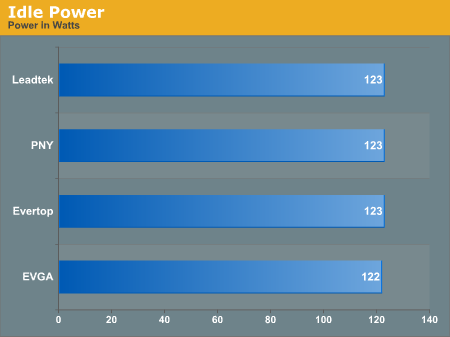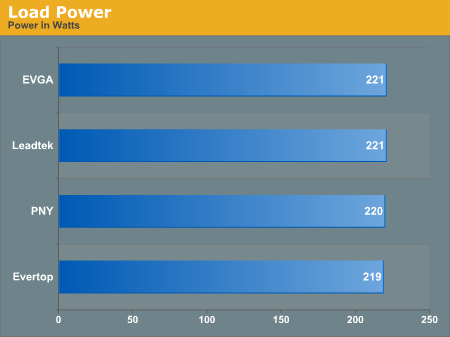The NVIDIA 6800 GS Closer Look: EVGA, Leadtek, PNY, and Evertop
by Josh Venning on January 27, 2006 8:53 AM EST- Posted in
- GPUs
Power, Heat and Noise
Power Load
To test the power load of the card, we measure the total watt usage of our test computer at the wall outlet, recording the power usage of our system in two different states. The first state is with the card installed and the computer is idle, and the second is during intensive performance tests (looped Splinter Cell benchmarks). This way, we are able to get a general idea of how the power usage varies between cards.
Heat
We also wanted to see how much heat these cards generated. We found that the EverTop 6800 GS generated the least amount of heat by a wide margin compared to the other three. The unique HSF design of this card may contribute to its low level of heat.
Noise
We were curious to see what kind of noise these cards generated as well. What is interesting here is that, similar to our heat tests, one card stood out among the rest. The EverTop GS was by far the most quiet of these cards, again perhaps due in part to the radical HSF design. The fact that it is the lowest clocked of these cards also plays a part here. The EverTop is the only card to use a non-reference HSF. Obviously, the Zalman fan, though bulky, does a better job of cooling the card while it keeps quiet. Below are the noise levels for each card.
For reference, the noise level of the room with the system off was 39.1.
Power Load
To test the power load of the card, we measure the total watt usage of our test computer at the wall outlet, recording the power usage of our system in two different states. The first state is with the card installed and the computer is idle, and the second is during intensive performance tests (looped Splinter Cell benchmarks). This way, we are able to get a general idea of how the power usage varies between cards.


Heat
We also wanted to see how much heat these cards generated. We found that the EverTop 6800 GS generated the least amount of heat by a wide margin compared to the other three. The unique HSF design of this card may contribute to its low level of heat.
| Graphics Card | Temperature |
| EverTop GeForce 6800 GS | 56 C |
| EVGA e-GeForce 6800 GS | 64 C |
| PNY GeForce 6800 GS Overclocked | 67 C |
| Leadtek WinFast PX6800 GS Extreme | 69 C |
Noise
We were curious to see what kind of noise these cards generated as well. What is interesting here is that, similar to our heat tests, one card stood out among the rest. The EverTop GS was by far the most quiet of these cards, again perhaps due in part to the radical HSF design. The fact that it is the lowest clocked of these cards also plays a part here. The EverTop is the only card to use a non-reference HSF. Obviously, the Zalman fan, though bulky, does a better job of cooling the card while it keeps quiet. Below are the noise levels for each card.
| Graphics Card | Noise Level |
| EverTop GeForce 6800 GS | 45.9 |
| PNY GeForce 6800 GS Overclocked | 50.1 |
| EVGA e-GeForce 6800 GS | 50.5 |
| Leadtek WinFast PX6800 GS Extreme | 50.7 |
For reference, the noise level of the room with the system off was 39.1.










56 Comments
View All Comments
bob661 - Friday, January 27, 2006 - link
I don't see why anyone would still be buying an AGP card when the prices differences between AGP and PCIe are negligible. And why buy a card like the 6800GS for an older board when the video is going to be bottlenecked by the old CPU?superkdogg - Friday, January 27, 2006 - link
Bob, umm, I don't know how to tell you this, but any Athlon64 socket 939 has AGP motherboards available for it. Bottlenecked by "old" CPU's..... And the price differences are more than negligible. PCI-e is significantly cheaper, actually.The problem is that for Intel users, most will need new memory and everybody will need a new motherboard.
Spacecomber - Friday, January 27, 2006 - link
I'm running a 6800GT with an Athlon XP clocked at 2.3GHz, and they are a good match for each other. Why should I upgrade a whole system when a better video card is enough to let me keep up with my gaming needs (mostly BF2 these days). The 6800GS is priced about right and the performance is about right for use in systems with the rough equivalent of a Pentium 3.0 GHz processor. And, the range of AGP cards still available is getting narrower; so, the interest in those that are still being made is sharper.Spacecomber - Friday, January 27, 2006 - link
I didn't really find benchmarks that just compared 6800GS cards to other 6800GS cards that helpful. As a buyer I'm going to probably pick the 6800GS card that is selling for the best price or has the best warranty or some other such feature, if I decide that a 6800GS is the right card for me. In order to do that, I need to see how this card compares to the competition, both from other nvidia cards and from ATI's cards.Ideally, these comparisons should also include SLI tests. Does the lack of pipelines come into play when running in SLI mode or not, compared to a 6800GT, for example?
When you write these reviews, you guys need to be asking yourselves the questions that a Anandtech readers, as consumers, will be asking.
nullpointerus - Friday, January 27, 2006 - link
Didn't the previous 6800 GS article do just what you wanted? I think I even picked the 6800 GS based on that article.Hacp - Friday, January 27, 2006 - link
How about showing the results of an overclocked gto? These things overclock pretty well, and should get to x850 pro speeds.